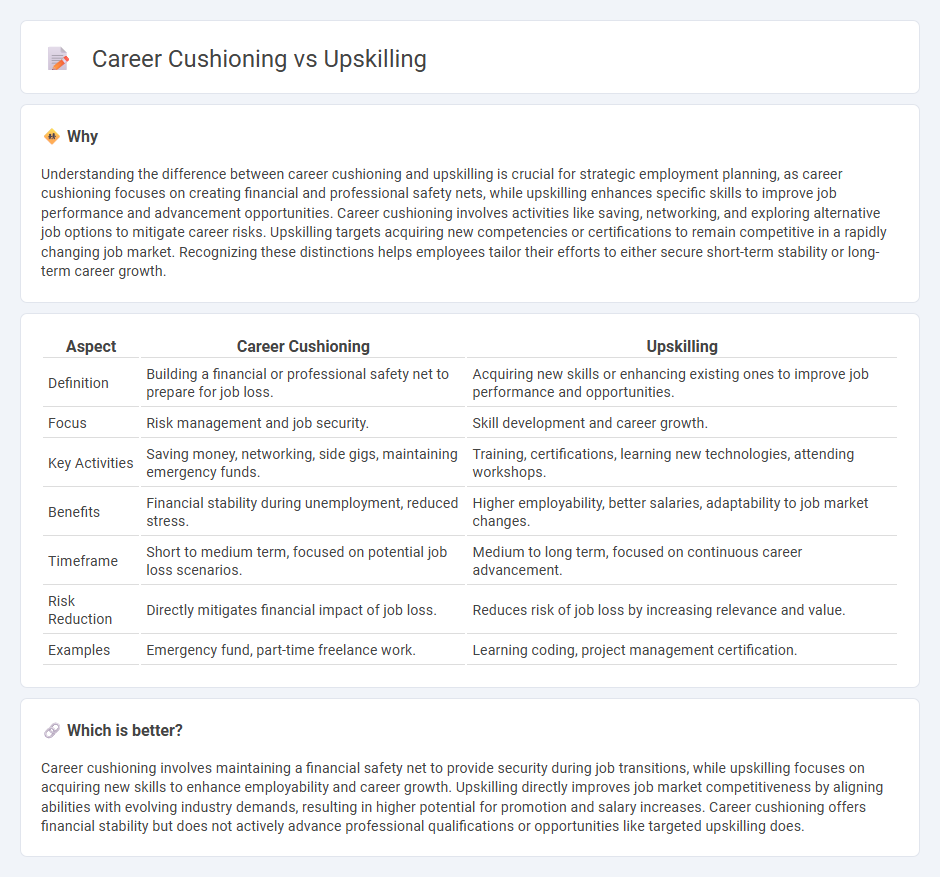
Career cushioning involves developing a financial safety net or backup plan to protect against job loss, while upskilling focuses on acquiring new skills and qualifications to enhance employability and career growth. Employers value upskilling as it directly contributes to increased productivity and adaptability in a rapidly evolving job market. Explore how balancing career cushioning and upskilling can secure your professional future in today's competitive employment landscape.
Why it is important
Understanding the difference between career cushioning and upskilling is crucial for strategic employment planning, as career cushioning focuses on creating financial and professional safety nets, while upskilling enhances specific skills to improve job performance and advancement opportunities. Career cushioning involves activities like saving, networking, and exploring alternative job options to mitigate career risks. Upskilling targets acquiring new competencies or certifications to remain competitive in a rapidly changing job market. Recognizing these distinctions helps employees tailor their efforts to either secure short-term stability or long-term career growth.
Comparison Table
| Aspect | Career Cushioning | Upskilling |
|---|---|---|
| Definition | Building a financial or professional safety net to prepare for job loss. | Acquiring new skills or enhancing existing ones to improve job performance and opportunities. |
| Focus | Risk management and job security. | Skill development and career growth. |
| Key Activities | Saving money, networking, side gigs, maintaining emergency funds. | Training, certifications, learning new technologies, attending workshops. |
| Benefits | Financial stability during unemployment, reduced stress. | Higher employability, better salaries, adaptability to job market changes. |
| Timeframe | Short to medium term, focused on potential job loss scenarios. | Medium to long term, focused on continuous career advancement. |
| Risk Reduction | Directly mitigates financial impact of job loss. | Reduces risk of job loss by increasing relevance and value. |
| Examples | Emergency fund, part-time freelance work. | Learning coding, project management certification. |
Which is better?
Career cushioning involves maintaining a financial safety net to provide security during job transitions, while upskilling focuses on acquiring new skills to enhance employability and career growth. Upskilling directly improves job market competitiveness by aligning abilities with evolving industry demands, resulting in higher potential for promotion and salary increases. Career cushioning offers financial stability but does not actively advance professional qualifications or opportunities like targeted upskilling does.
Connection
Career cushioning and upskilling are interconnected strategies that enhance job security by preparing individuals for market changes and emerging opportunities. Upskilling equips employees with new skills and competencies, making career cushioning more effective in mitigating risks associated with job displacement. Both approaches contribute to sustained employability and adaptability in a dynamic job market.
Key Terms
Skill Development
Upskilling involves actively enhancing specific skills to increase job performance and career advancement opportunities, while career cushioning emphasizes preparing for potential job loss by diversifying skill sets or pursuing side income avenues. Both strategies prioritize skill development but serve different purposes--upskilling aims at growth within the current role, whereas career cushioning provides security against market volatility. Explore effective methods for skill development to balance growth and security in your career.
Job Security
Upskilling involves acquiring new skills or enhancing existing ones to remain competitive and adaptable in the job market, directly boosting job security through increased expertise and value to employers. Career cushioning entails strategically building a network, savings, and alternative job options as a safety net against potential layoffs or industry shifts, offering a proactive approach to job security. Explore effective job security strategies by understanding the roles of upskilling and career cushioning in today's workforce.
Marketability
Upskilling enhances marketability by developing in-demand skills aligned with industry trends, increasing employability and career growth opportunities. Career cushioning involves building a financial and professional safety net to mitigate job market uncertainties, ensuring stability during transitions. Explore strategies that balance skill development and security to maximize your marketability.
Source and External Links
Upskilling and Reskilling - Upskilling involves acquiring new skills or enhancing existing ones to stay competitive in the job market, achieved through various learning methods.
Upskilling: What It Means and How It Can Help Your Career - Upskilling is about learning new and enhanced skills that relate to your current role, essentially "leveling up" your skills for career advancement.
How to Upskill Employees: Best Practices, Methods - Upskilling involves improving or expanding an employee's existing skill set to enhance proficiency in their current role through methods like training programs and skills gap analysis.
 dowidth.com
dowidth.com